Cuba Travel Guide: Things To Do, Costs, & Travel Tips
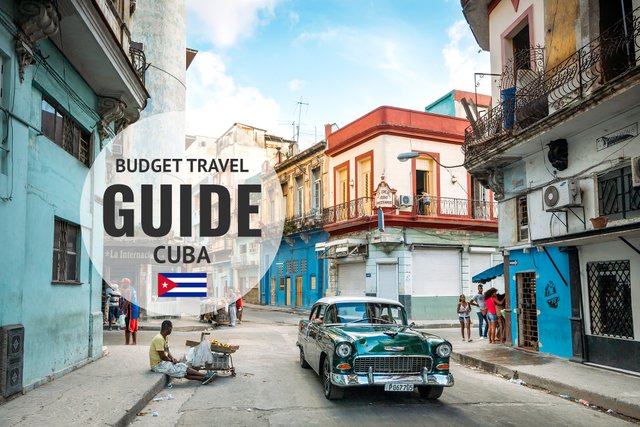
Cuba Travel Tips
Is it possible to travel Cuba on a budget? Learn how much it cost me to backpack through Cuba — along with my favorite travel tips, things to do, and more.
Budget Travel Guide: Cuba (2017)
The island of Cuba was “discovered” and claimed for Spain by Christopher Columbus during his first voyage to the New World in 1492.
While it’s been a popular travel destination for years, due to an economic embargo, Americans haven’t been able to visit easily until now.
However what draws people to the tropical Caribbean island of Cuba is much more than beaches and antique 1950’s cars, although there are plenty of those.
In Cuba you can wander bustling city streets, go hiking in the mountains, learn about the history of tobacco, or simply soak up the country’s 1950’s time-warp appeal. Get a taste of what it’s like to live in a socialist country.
While Cuba can sometimes be a confusing and challenging place for many travelers, I invite you to give it a try anyway, and experience some Cuban magic for yourself.
There are many wonderful reasons to visit Cuba for your next vacation.


Budget Travel In Cuba
Cuba is generally pretty affordable, especially compared to other Caribbean Islands, yet is more expensive than other parts of Latin America like Mexico or Central American nations. With a special 2nd currency just for tourists, you’ll be forced to pay tourist prices most of the time.
Budget travelers can survive on around $50 USD per day.
Cuba’s local currency is the Cuban Peso (CUP- ₱) and it translates to ₱24 CUP for $1 USD. However as a tourist, you’ll be using Cuba’s secondary currency just for tourists, the Cuban Convertible Peso (CUC – $) which is pegged to the US Dollar. So $1 CUC = $1 USD.
You will need to exchange US dollars for CUC, but there is a special 10% penalty fee for this service. So it’s often cheaper to exchange Euros, Canadian Dollars, British Pounds, or Mexican Pesos for CUC instead.
If you’re an American, you still can’t use your credit cards or ATM cards in Cuba. They won’t work because of the economic sanctions in place.
So you MUST exchange cash to fund your whole trip unless you’re on a pre-paid tour. The other option is buying a foreign pre-paid debit card from banks in Canada or Mexico.
There’s an official currency exchange booth outside the airport in Havana. You can exchange your leftover CUC back to US dollars (or whatever) when you leave the country too.
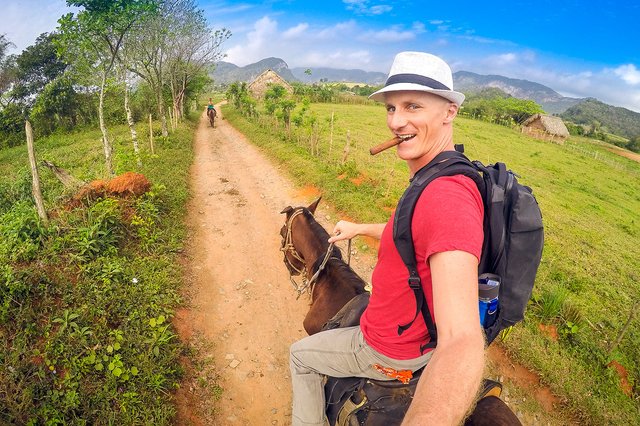
My Cuba Travel Budget
TOTAL DAYS = 10
TOTAL SPENT = $900 USD
DAILY AVERAGE = $90 USD
Please use these numbers as general guidelines only. Remember, everyone travels differently. Your personal travel budget in Cuba may vary.
When I traveled through Cuba for 10 days in 2016, I spent a total of $900 for an average of $90 USD per day.
Some of the things I splurged on included renting a car for more freedom to explore the island on our own. Rental cars in Cuba aren’t cheap — ours was $83 CUC per day (which we then split 4 ways with friends).
Scuba diving, tickets to Havana’s famous Tropicana Show, cigars, and a classic car city tour were some other activities I chose to include in my own trip. Your own choices will affect your travel budget in Cuba.


Where To Stay In Cuba
While you can find fancy hotels in Havana and all-inclusive resorts in Varadero, the best accommodation options in Cuba are called casas particulares.
Casas particulares are like local guesthouses. The Cuban government allows some residents to rent the spare rooms in their homes for extra income, and as a traveler you get a more local experience.
To find a casa, you simply walk around a neighborhood, pop in and ask to see a room, and decide if you want to stay there. Most are easy to find because they’re marked with a special sign that looks a bit like an anchor.
Prices will vary depending on the region. A double room costs between $25 – 40 CUC with breakfast included. If staying with locals isn’t your thing, there are other options too. Just a lot more expensive.
• Casas Particulares: $25 – $40 per night
• Mid-Range Hotels: $90 – $150 per night
• Resorts & Fancy Hotels: $200 – $400 per night
I always use Booking.com and AirBnB to find great deals on accommodation when I travel. You can use both in Cuba too!


Eating Cuban Food
While many travelers complain about Cuban food and its availability, I found food in Cuba pretty cheap and tasty. Not to mention those famous Cuban mojitos for only $1 or $2!
The lowest-cost options are Cuban sandwiches or Cuban pizzas at street-side stores called “paladares”. These meals can cost as little as $1, but are super basic too. Cuban pizzas reminded me of frozen microwave pizzas. Nothing to write home about…
If you’re a dedicated foodie, and need more choices, you can find large plates of lobster, shrimp, crab and fish for about $7 at restaurants near the coast. There’s also traditional Cuban cuisine called ropa vieja (old clothes) which is basically pulled pork with gravy, served with rice and beans for about $5.
Larger restaurants are generally set up for tourists, with high tourist prices around $15-$20 for a meal. Most Cubans can’t afford to eat at these places. They cook at home, using government rations called Libreta de Abastecimiento to pay for basics like rice, sugar, and cooking oil.
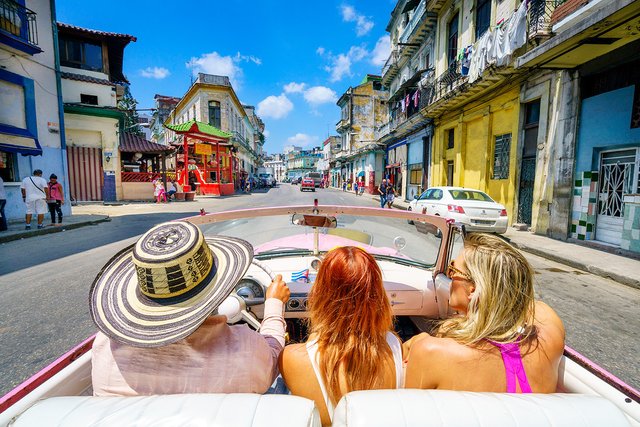
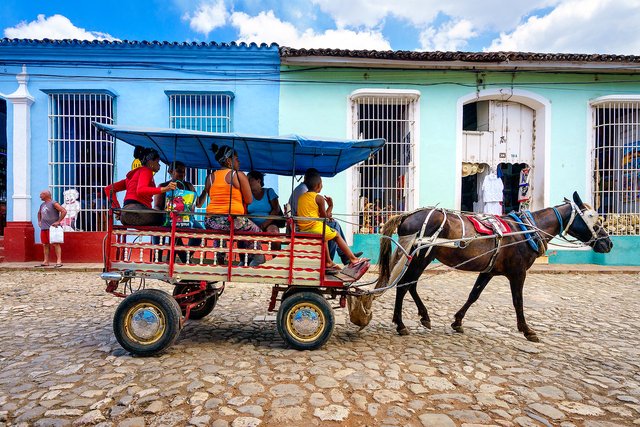
Transportation In Cuba
Flights
The major airports in Cuba are in Havana (HAV) and Santiago de Cuba (SCU). For years, many Americans traveled to Cuba through foreign gateway cities like Cancun, Mexico City, or Toronto. However in 2016 the US government started allowing commercial flights to Cuba from the United States. New York, Miami, and Los Angeles all offer flights.
Buses In Cuba
Bus travel in Cuba is pretty comfortable. There’s one main bus line called Viazul. Cuban buses are cheap, but the routes fill up quickly, so you usually need to get your tickets in advance either online or in person at least a day or two early.
Cuban Taxis
Taxis are available in the more developed cities of Cuba like Havana, Varadero, and Trinidad. Official taxis, in modern cars, will be marked and some even have meters. Old classic car taxis are more expensive, often with set rates of $8-$10 per ride. Try to negotiate a price before you get in.
Almendrons are local shared taxis that run in some cities. It’s the cheapest option at 0.50 CUC per ride, however they aren’t easy to figure out if you don’t speak Spanish. They run on set routes, simply flag one down and jump in with everyone else. Usually old 50’s vans or Toyota Landcruisers.
Bicycle Taxis are another option. Officially they aren’t allowed to pick up tourists, but they still do. A ride costs about $1 CUC. You could get kicked off early if the driver notices police nearby.
Renting A Car
Renting a car in Cuba is possible, but it’s not easy. The online car rental systems there generally don’t work for foreigners. The best option is to inquire by email or phone about a rental a few weeks or more before your trip. Don’t expect to just show up at the airport and book a rental car, they simply don’t have enough for the demand.

Visa Requirements
For years it was possible for Americans to visit Cuba through foreign gateway countries like Mexico or Canada first. Then, President Obama opened a loophole for American tourism to Cuba, even though Congress hadn’t actually changed the law yet.
It was a kind of “wink, wink, nudge, nudge” situation. No one was enforcing the law. You signed a piece of paper when you got on the plane saying you fit one of 12 special categories (that don’t include tourism), and no one checked.
Regular flights to Cuba from the United States started up, and things were looking good!
However it seems President Trump is clamping down on that loophole and will be making it tougher again by banning People To People trips, the category most people were using.
Americans can still travel to Cuba independently, but you’ll need to choose an approved travel category other than People To People tours, which Trump plans to ban. Declare a category like Support For The Cuban Peoplewhen booking flights, lodging and when you return to the US.
You can build an itinerary containing activities that meet the criteria for the category you chose, or get help from local experts to plan a legal trip (5% discount for Expert Vagabond readers!).
Another option is to fly into Cuba from a Foreign Gateway City like Cancun, Mexico or Toronto, Canada. This is what I did, and I share more details about that here.
Every traveler needs to purchase a Tourist Card for $20 ($50+ if traveling from the United States) regardless of nationality. This is most commonly done at the departure airport itself, or online/through the mail with your airline.

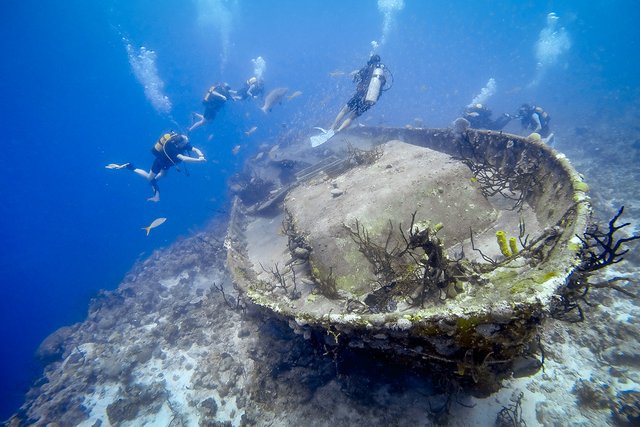
gs To Do In Cuba
Havana
It’s impossible to skip the capital of Havana on a trip to Cuba. Havana Viejo (Old Havana) is the historic city center, and was declared a UNESCO World Heritage Site in 1982. The city is full of beautiful old architecture, interesting people, and of course – all those incredible classic cars.
• Rent a classic car for a tour through the city, $30 CUC for one hour.
• Visit some of Hemingway’s old hangouts, like La Floridita and La Bodeguita del Medio.
• Smoke a Cuban cigar overlooking the ocean at Hotel Nacional
• Walk the Malecon at night with a box of cheap corner-store rum.
• Attend the world famous Tropicana nightclub for a colorful show.
Varadero
Located on the Hicacos Peninsula about 140 km from Havana, Varadero is a popular resort town for tourists. The ivory-white sand beaches are gorgeous! While many beaches in Varadero are part of private resorts, there’s a large free public beach section too, which is just as beautiful.
• Grab a beach chair, buy a few Cuba Libres, and work on your tan.
• Rent a kayak or sailboat and cruise along the coast.
• Eat at one of Varadero’s amazing seafood restaurants.
Viñales
Viñales is a lush green valley surrounded by mountains located west of Havana. It’s a fun small town to visit if you’re into nature, caving, rock climbing, or learning about the art of cigar making. Viñales is Cuba’s tobacco capital, home of the best cigars in the world.
• Visit a tobacco farm and learn how to make Cuban cigars.
• Rock climbing on the karst limestone cliffs.
• Rent an ATV for an off-road trip through the valley.
• Go horseback riding, or join a cave tour.
Trinidad
Trinidad is a picturesque colonial town lined with cobblestone streets and pastel-colored houses. It was the epicenter of the Spanish sugar trade in the 18th century, where sugar barons become extremely wealthy off the back of African slave labor. Many of the old buildings have been restored.
• Hang out on the steps of Plaza Mayor with a mojito to watch the sunset.
• Visit some art & history museums, like Museo de Arquitectura or Museo Romantico.
• Climb the bell tower at Iglesia de San Francisco for great city views.
• Ride a bike to Playa Ancon, a beautiful white sand beach.
• Go swimming under waterfalls at Topes De Collantes National Park

Budget Travel Tips
While Cuba can be affordable, it’s not an easy place to travel on an extreme budget. It takes some work. Try eating at locally run paladares whenever you can. Use the somewhat confusing but cheap local shared taxis, or split a 1950’s tourist taxi with other travelers.
Bring a filtered water bottle, as bottled water can sometimes be difficult to find outside of major cities. Stay with locals in casas particulares whenever possible to keep accommodation costs down.
READ MORE: Best Travel Tips After 7 Years Traveling
Off The Beaten Path
There is a cool national park called Topes de Collantes located about an hours drive from Trinidad. It has many hiking trails that lead to different waterfalls, and not many people visit them.
Some of the best waterfalls are El Nicho and Vegas Grandes, both are over 100m high, and its a great way to experience some of Cuba’s mountains. You can book a tour from Trinidad, or go on your own like we did if you have a car. Beware, the roads are pretty bad up there!


Best Time To Visit Cuba
When is the best time to visit Cuba? Regardless of the time of year, average temperatures in Cuba are very pleasant ranging from 70s F to 80s F.
However the best time to visit is arguably from December to May, as the climate tends to be mild and skies are often sunny.
Wet season is between June and October, with the heaviest rain & hottest temperatures in July & August. It’s generally a less-desirable time to visit Cuba, and hurricanes are also a threat.
The tourist high season in Cuba runs from December through March, due to great weather and large numbers of Canadians escaping the winter snow in their own country.
If you want decent weather, and fewer tourists, April, May, and November are good choices.
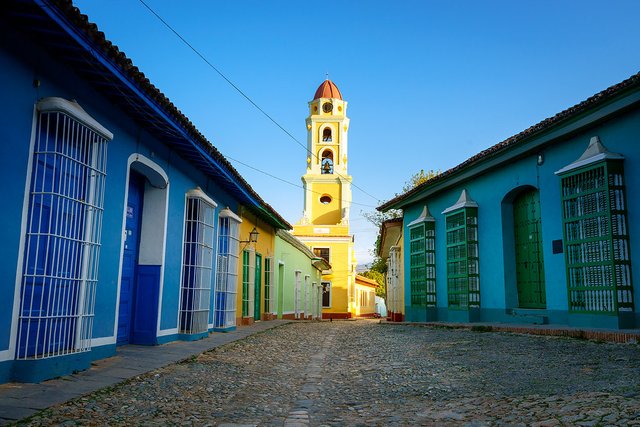

Internet & Cell Phone Service
Internet in Cuba isn’t available everywhere, but it’s possible to find wifi spots in most major hotels, large public parks, and even some casas particulares. For a list of all the known wifi hotspots in Cuba, click here.
To get online you need to buy an internet scratch-card from ETECSA (Cuba’s national telecommunications company). They cost between $2-6 for an hour of service. You can buy the cards in front of the airport in Havana, at major hotels, at ETECSA kiosks, or from Cubans themselves.
To use services like Skype or Snapchat, you’ll need to install a good travel VPN before you arrive. The internet isn’t super fast, but it’s fast enough to upload travel photos to Facebook & Instagram if you’re patient.

Challenges In Cuba
The lack of internet can be challenging at times, as we’ve all become comfortable finding our way around with help from Google Maps, or searching online for answers to travel questions.
Galileo Maps ( IOS | Android ) has offline maps of Cuba, so you can find your way around using a smartphone even without internet.
If you don’t speak Spanish you might often find yourself at a loss in Cuba, as the majority of people don’t speak any English. Without Spanish it’s difficult to arrange things, but not impossible.
While Cuba is a very safe place to travel, there are many scammers too. Especially around Havana. Some popular scams in Cuba include:
• Being invited to a bar/club from someone off the street, then getting stuck with a huge mysterious bar tab.
• Women asking you to buy milk for their babies, at inflated prices from shops that are in on the scam.
Everyone isn’t trying to scam you — but you still need to stay cautious and use common sense.
Thank you so much for this. It has been my ambition to visit Cuba for at least a decade now. The only reason I didn't was because of the situation with the USA which I visit often as my son lives there. Brilliant travelogue and very informative. Thanks again I have followed and upvoted.
This is Matthew Karsten's content. Why are you plagiarizing without giving credit?